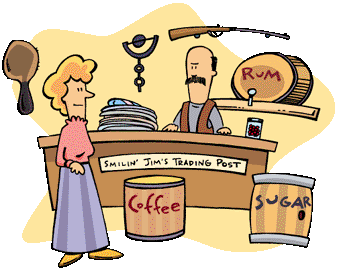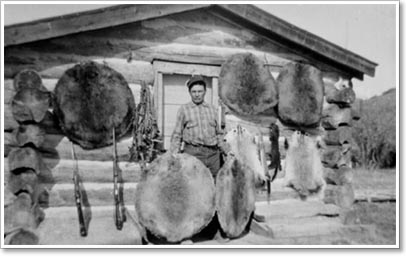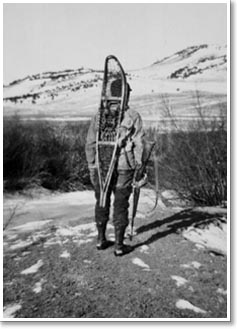American Mountain Men and Western Fur Trade: Trapping and Trading
Updated: August 4, 2020

The hunting parties of the first fur trading years were called brigades. Ads in St. Louis newspapers called for some 100 "enterprising young men" to be employed for one, two, or three years at a salary of about 200 dollars per year. These men were taken to some remote fort where they would camp for a few days. The operator of the fort would then sell them supplies like guns, traps, leather pants, sugar, coffee, knives, bullets, awls, and maybe a frying pan. They would charge around ten times the St. Louis price for these items. Except liquor; liquor they watered down and sold for about fifty times the St. Louis price. Usually the men ended up in debt. The trappers also bought things like beads, mirrors, or fusses (pistols) which they, in turn, traded to Indians for meat, services, or additional furs. Some men liked to trade with Indian women who would sew or repair clothes for them.
Usually, men who had worked in the mountains for a few years led these brigades. Jedediah Strong Smith, Jim Bridger, and John Colter were among the men who followed up on those early newspaper ads. All three became well-known mountain men. As hunting parties pushed further into uncharted wilderness, they came under increasing attack from Indian tribes hostile to American expansion, particularly the Blackfoot. Sometimes an entire year's worth of supplies and furs were lost. Indians captured John Colter more than once. On one occasion he reports that a band of Blackfoot killed his partner but then turned him loose for a "human hunt." Colter escaped. Leaders soon decided to reform the brigade method of trapping. They were losing all their profits. The Rendezvous replaced the brigade, and here is where the real mountain man lifestyle is born.

Mountain men, free traders, began to venture out on the spring and fall hunts alone or with just a couple of partners. This way, if individual trappers were either unsuccessful or killed, the entire trapping season was not lost. Montana was fierce country. These men had many wild adventures and told even wilder stories. They lived on diets of meat. Some of them became sick due to a lack of fresh vegetables. Often, the meat was either "green"- still warm from the heat of the live animal- or else, if not properly cured, was rotten. They brewed thistle-root soup. They drank "buffalo cider," a fluid found in the stomach of the buffalo, to quench their thirst. They learned to survive from watching and living with Indians or more experienced trappers. Most mountain men could understand one or two Indian languages at least well enough to trade with them. They would spend the entire spring and fall on the hunt, setting traps and trading with Indians. Then, during the summer, they gathered for Rendezvous.
The first Rendezvous was held in 1825 . Supply trains (these weren't actually railroad trains) came out to bring the few goods that mountain men might need or want. Free traders brought their furs to barter for supplies or money. Organizers of the Rendezvous then took the furs to sell back East. The Rendezvous was a wild and raucous event. The men held horse races and shooting matches. They wrestled, fought, talked, and drank. After a week or two everyone disbanded and went back to the hills. The winters passed by slowly. While the creeks and ponds were frozen, little hunting was done. Free traders were not usually welcome in established forts over the winters. If game and firewood could be found, winters were pleasant times. Some men taught themselves to read over the winter season. A couple of favorite wintering camps were near Thompson's River and Yellowstone (now Livingston), both in Montana.

Mountain men lived tough lives fighting off bear, hunger, and even other men. But the trappers didn't journey west to get rich. They did it because they loved the land and couldn't imagine a more magnificent place to live. As a sign of affection, they called each other "old coon." Jedediah Strong Smith, after nearly dying of thirst while crossing the Great Basin, wrote in his journal, "My dreams were not of Gold or ambitious honors, but of my distant, quiet home, of murmuring brooks, of cooling cascades." As the textile industry developed and fashions changed in Europe, the fur trade switched over from beaver pelts in favor of buffalo robes. Buffalo were hunted out on the plains until both the buffalo herds and the fur trade nearly died out. The last fur trading post, Fort Union, was built in 1828 on what is now the Montana/North Dakota border. The last of the buffalo from the free range were shot in 1884.
Many of the old trappers became guides for the Army or for settlers coming west. But the area had already been mapped by these men. They were really not guiding people on how to get from one place to another, but rather, on how to survive in the rugged wilderness. They passed on knowledge of weather patterns, of edible plants, of animal habits, and of Indian traditions. Jim Bridger even interpreted at the Fort Laramie treaty convention of 1851, which gave Indians control of their sacred Black Hills in exchange for opening Kansas and Nebraska to white settlement. He also discovered a mountain pass, Bridger's Pass, which was eventually used as a mail route, as a part of the Oregon Trail, and today, by US Interstate 80. Finnan McDonald, a clerk of David Thompsan was the first white man to cross Marias Pass. Today Marias pass is an important railroad crossing over the Continental Divide.
The USGS counts some 99 forts built in Montana between 1807 and 1885. Many of these forts were fur trading posts. Before the fur trade ended, the entire northwestern United States had been mapped. Routes for wagons and trains had been surveyed. Steamboats were moving up the Missouri River from St. Louis right into Montana. In fact, when Montana's first steamboat, the Yellowstone, reached Fort Union, that fort became the most remote inland port in the world. Outposts had been established all across the region. But more importantly, the West had evolved in people's minds from a savage wilderness into a romantic setting. Children in the East grew up reading the journals of Lewis and Clark and other western figures. They dreamed of becoming wilderness heroes themselves. They wanted to head west. And head they did. Following the fur trade, men and women moved into Montana to search for gold, to homestead farms, to harvest timber, and to find a new way of life. Those "old coons" of the fur trading era probably never imagined that so many "pilgrims" would be able to survive in the Rockies, but they sure knew a good thing when they saw one. Wrote Jedediah Smith: "I of course expected to find Beaver, which with us hunters is a primary object, but I was also led on by the love of novelty common to all..."
Updated: August 4, 2020

